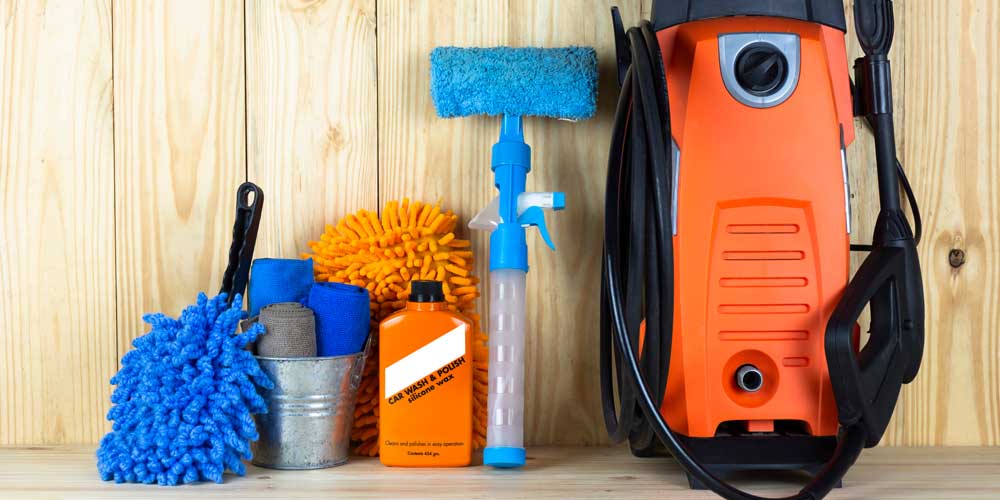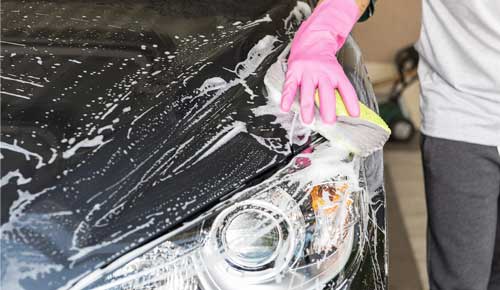An essential part of looking after your car is keeping it clean which is why we’ve created this handy driver’s guide to cleaning your car at home.
Some drivers prefer using a professional valet service or a car wash machine at a garage. Both of these are great choices if you’d rather not clean it yourself but we hope that with this guide we make cleaning your car a little less daunting.
One thing to note is that some valet services and car washes will not clean the inside of the vehicle – if this is the case then you can still use steps two to four to do this yourself.
How to Clean Your Car in 10 Easy Steps
To make this guide easy to follow we’ve broken it down into 10 simple steps that will take you from a parking a dirty car to driving a sparkling vehicle.
1. Get the Right Equipment
The first step in getting your perfect clean car is to make sure you have the right equipment to get the job done.
For drivers looking to clean their car at home for the first time we know this can be daunting as there are a lot of different products for each stage of the process but the essentials that you will need are:
- Specialised car cleaning soap or wash wax
- A sponge
- A micro-fibre cleaning cloth
- A bucket
Along with these products you want a water source, this can be a pressure washer, garden hose or even just a bucket. While it’s easier for you to wash the car with a hose or pressure washer you can make do with a bucket if you don’t have access to them.
Additional products you might want to use to get a high-quality finish include:
- Car polish / wax
- Glass spray
- Special wheel brush
These will help you get the best finish possible but aren’t essential for a clean car.
We also recommend cleaning the vehicle interior as this is where you will actually spend time and a messy or dirty interior can have a pretty large impact on your comfort and driving. In order to clean the interior you’ll need:
- A hoover
- Leather / interior cleaner
- Cleaning rag
- Microfibre clothes

2. Prep Your Vehicle
Before you actually clean your vehicle, you want to prepare it to make cleaning as easy and straightforward as possible for you. You’ll need to prepare the inside and outside of the vehicle to get the best possible results.
To prepare the outside of the vehicle we recommend brushing off any dry dirt or leaves from the car. You also want to make sure all of the windows and doors are securely closed to ensure now water gets inside the vehicle.
For the inside of the vehicle, you want to clear out any of rubbish that has been left in the vehicle, we recommend having a plastic bag to hand for this. Additionally, in order to give you the space to move and clean the full interior you should clear any belongings out temporarily.
H3 3. Start on the Inside
We recommend cleaning the interior of your car before you clean the exterior. This is because if you might get water inside the vehicle if you allow it to dry naturally and clean the interior while it dries and it’s also likely you might get a little messy yourself while clearing the exterior and you don’t want to bring this into the vehicle.
Once you’ve cleared out the vehicle you want to pick up any larger rocks or debris you may have in the vehicle by hand to throw them away. Then you can use a hoover to clean the remainder. As well as hoovering the floor and floormats you will find a hoover useful for cleaning the seats, if they are cloth, the door storage pockets and other nooks that the thin head attachment fits into.
4. Organise Your Belongings
We know that all drivers have essential items that they keep in the car (we even have a list of essential car items) and after you have cleaned the inside of the car you will want to put these back into the vehicle.
In order to minimise distractions for you when driving and reduce the risk of things moving around we recommend securing smaller items in the glovebox, door pockets or seat pockets as well as in the boot.
Some drivers find it useful to use a plastic basket or bucket to store these items securely in one location as well.
5. Rinse it Off
Once you’ve got everything neat and tidy inside the vehicle then you can move to the exterior.
Before you use any kind of cleaning solution the first thing you want to do is rinse the vehicle off. If you have a hose or jet washer then you should direct this at the vehicle, making sure to move over the entire car from top to bottom. If you are using a bucket then you’ll want to pour from the top of the vehicle and allow the water to flow downwards. You will probably need to use a few buckets worth to cover the entire vehicle and may also want to rinse the wheels separately as they will get a lot of dirt built up there.
6. Soap and Scrub
The next step is to fill another bucket with warm water and add the car shampoo. Different car shampoos / soaps will need different concentrations so we advise you read the instructions on the bottle first and then you will want to use a sponge and this water to clean your car. You may need to rub at particularly dirty spots a little longer than cleaner areas. You may want to use a specialist brush for the wheel alloys and we would recommend not using this on the rest of the car as it may cause damage. If you would like to use a brush on the paintwork then you can get brushes that have softer bristles and are designed for using on the vehicle.

7. Rinse Again
Once you have used the soapy water to clean the vehicle you will then want to clean it off by rinsing it down. You should repeat the same steps you used to rinse the vehicle originally and make sure that there are no bubbles left on the vehicle.
8. Dry It Off
Once you have finished washing the vehicle you will want to dry it in order to avoid any streaks or smears to give you the best exterior finish possible.
You will want to use a microfibre cloth and either pat or use a small sideways motion to dry the paintwork. This is the best type of cloth to use as it will not damage the paintwork and is absorbent.
9. Clean Your Glasswork
If you have specialist glass cleaner, then now is the time to use it.
You should spray your glass cleaner over half of the windscreen and then using a clean microfibre cloth in a circular motion to clean the area. Once this is completed move to the other side of the vehicle and repeat the process on the other half of the windscreen. Once the windscreen is complete you can then follow the steps on your side and rear windows.

10. Wax and Polish
You can get an all in one polish which acts as a wax and polish combined or you can get separate wax and polish.
An all in one polish will get the job done a little quicker for you and provide about a month’s worth of protection while separate products will take a little longer with drying times and will offer you longer protection.
You will want to apply the polish using a clean microfibre cloth or foam applicator using straight lines other small areas. Once the panel you are working on is complete you should then use a fresh microfibre cloth to remove the polish. Repeat this process across every panel until you have polished the entire vehicle.
If you are using a separate wax then you will want to repeat the process with the wax to give an added layer of protection.
Car Cleaning FAQS
How Long Does It Take to Wash Your Car?
This depends on how clean you want your car to be. In general simply washing your car will take around an hour. If you are polishing it afterwards as well the we recommend setting aside a few hours to get the job done quickly.
What Do You Need to Wash Your Car?
All you need to successfully wash your car is:
- A water supply
- A bucket
- Car shampoo / soap
- A sponge
- Microfibre clothes
How to Clean Your Car Without a Hose
If you do not have a garden hose then you can still clean your car at home. All you’ll need is a bucket and a little patience.
How Often Should I Wash My Car?
We recommend washing your car once every six to eight weeks. If you are driving a lot or in particularly muddy areas then you might want to drop this down to once every month or so.
If you’d like to learn more about looking after your car, then head back to our guides section to see all our dedicated driver content.
